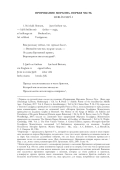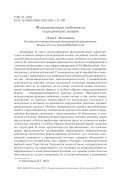В статье аргументируется предположение, что в поэтических вставках в Англосаксонскую хронику сочетаются различные способы изображения времени: абсолютное календарное время от Рождества Христова (Anno Domini); сакральное время, заданное церковными праздниками; относительное время, измеряемое правлением монарха от восшествия на престол до кончины; генеалогическое время, основанное на династических именованиях правителя и представителей его рода; пространственное время, определяемое хронотопом. Хронотоп выполняет композиционную функцию во всех поэмах Хроники: в «Битве при Брунанбурге» акцент на хронотопе позволяет расширить пространственно-временную перспективу и оценить значимость победы в масштабах вселенной; в «Завоевании пяти бургов» с помощью хронотопа легитимизируется освоение нового пространства и возвращение исконных земель; в поэтической вставке о коронации Эдгара Миролюбивого восшествие на трон земного монарха уподобляется благодаря хронотопу посвящению в чин духовного лица. Хронотоп поэмы о кончине Эдгара Миролюбивого приобретает апокалиптический символизм, устанавливая пространственно-хронологическую обусловленность природных катаклизмов и бедствий в стране кончиной короля. В поэме об убийстве Альфреда хронотоп получает аллюзивную функцию, наделяющую его ассоциациями с панегирической поэзией и позволяющую противопоставить былое величие англов их бесславному настоящему. Хронотоп в поэме о кончине Эдуарда Исповедника вводит контраст преходящей, временной власти над земным королевством и вечного спасения в мире ином. Изучение хронотопа в поэмах Англосаксонской хроники, проведенное в статье, позволяет пролить свет на восприятие времени и способы освоения пространства в средневековой Англии.
Merlínusspá is included into the short version of Breta sǫgur which goes back to Geoffrey of Monmouth’s Historia Regum Britanniae (c. 1136) and is preserved in Hauksbók (AM 544 4to). The article argues that the main function of Merlínusspá is not only to narrate war and conflict but also to present British legends with the help of traditional Old Norse themes (feuds, the enmity of kinsmen, the death of all living things) and poetic means (Eddaic meter fornyrðislag, skaldic kviðuháttr, skaldic syntax with interwoven sentences and skaldic phraseology: kennings and heiti.
The article argues that Clári saga presents a rare example of plot, genre and style contamination. Its composition unites two plots: the bridal quest (involving the trials of the eponymous hero) and the taming of the shrew (involving the trials of the heroine). The latter appears unmotivated (because by the end of the bridal quest narrative the heroine is sufficiently tamed by the loss of her virginity) but can be accounted for by the influence of the canons of the fairy tale. In terms of genre, as is shown in the article, Clári saga combines themes and images of the fairy tale, chivalric romance and exemplum. The saga is permeated by characteristically folklore motifs and compositional features: its structure is determined by the use of the sacred number three (three trials of the hero, three trials of the heroine, three scenes of the hero’s flogging, three scenes of blows received by the heroine from the hero, three visits of the hero, three scenes of the construction of tents, three episodes of Perus’ reign etc), endowed in the narrative with an enhanced magic effect. The genre of romance is dominant in the first part of the saga through the following characteristic features: the action is set in a chivalric milieu; the characters belong to courtly society, with its luxurious way of living and sumptuous feasts; and canons of chivalrous behaviour and courtesy are observed by all characters except the main ones. The second part of the saga with its inherent misogyny and didacticism, focuses on the trials of the spirit and the body, the action takes place in an atmosphere of extreme poverty and is centered on sufferings, hardships and deprivations, aimed at testing the endurance and loyalty of the heroine and providing a model for other women, thus paying tribute to the genre of exemplum. Genre contamination is sustained by the stylistic features of the saga, characteristic of exempla (‘learned’ style, Latinised syntactic constructions, Latin borrowings), folklore (proverbs, repetitions, parallelisms, an emphasis on numerals) and chivalric romance (cf. the use of words: kurteiss ‘courteous, chivalrous’, kurteisi ‘chivalry, courtesy’, riddari ‘knight’). Borrowings from Middle Low German, which in the context of the saga in some cases acquire emotionally coloured pejorative connotations, are mostly given the function of a stylistic device and become an integral part of the speech characteristics of heroes. Whether the compiler of the saga was a translator or a creator, whether his name was Bishop Jón Halldórson or Bergr Sokkason, he perfectly mastered the art of narration: by creating the effect of the author’s presence through rhetorical questions, by enhancing the impact of the story with the help of references to collective wisdom, proverbs and sayings, by using multiple verbal games and by employing borrowings from Latin and Middle Low German in the speech characterisation of heroes. His literary gift and sense of style made Clári saga not only a model for numerous imitations in the Middle Ages but also a source of entertainment for today’s readers.
В статье рассматриваются функциональные характеристики основных жанров скальдической поэзии: хвалебных песней, поминальной драпы, выкупов головы, щитовых драп, любовных и хулительных стихов. К скальдическим жанрам применяются понятия сальвационной и хтонической функции слова, сформулированные О.М. Фрейденберг. Хтонической функцией наделяются хулительные стихи скальдов, неразрывно связанные с рунической магией. Сальвационную роль приобретают выкупы головы с характерной для перформативов семантикой (автореферентностью, автономинативностью, эквитемпоральностью). Сальвационная действенность выкупов головы достигается благодаря направленности речевого акта не на адресата, но на самого создателя поэмы, использованию перформативных формул и особым образом структурированной формы - сверхформализованного размера рунхент. Прагматическая, волюнтативная функция любовных стихов состоит в том, чтобы оказать воздействие на адресата, манипулируя его ментальным состоянием и поведением, и заставить его произвести определенное действие (даровать расположение скальду). Помимо мемориальной задачи (увековечивании памяти о прославляемом), поминальные драпы исполняют жизнеутверждающую функцию, связанную с представлением об обновлении и жизненной силе рода. Вопреки распространенному мнению, щитовые драпы представляют собой не вербальные описания щита, но аллюзии на мифологические сказания в особым образом организованной форме, заданной его структурой. В статье аргументируется предположение, что щитовые драпы представляются своебразными хранилищами мифологических кеннингов: поэтическая форма призвана облегчить для скальдов запоминание кеннингов, а прозаический контекст содержит объяснение и мотивирует их употребление. Для «Драпы о Рагнаре», содержащей сцены рыбной ловли Тора, битвы Хьяднингов, пахоты Гевьон, нехарактерны ни описательность, ни нарративность, ни установка на коммуникативность. Маргинальность коммуникативной функции для произведений скальдов обусловлена не только семантикой, но и стилистическими и языковыми особенностями: использованием кеннингов с их информативной бедностью, паратаксисом, нарушением прямого порядка слов, употреблением вставных и переплетенных предложений, затемняющих смысловую огранизацию полустрофы, повышенной ролью звуковых повторов, характерной для ритуально-магической словесности.




